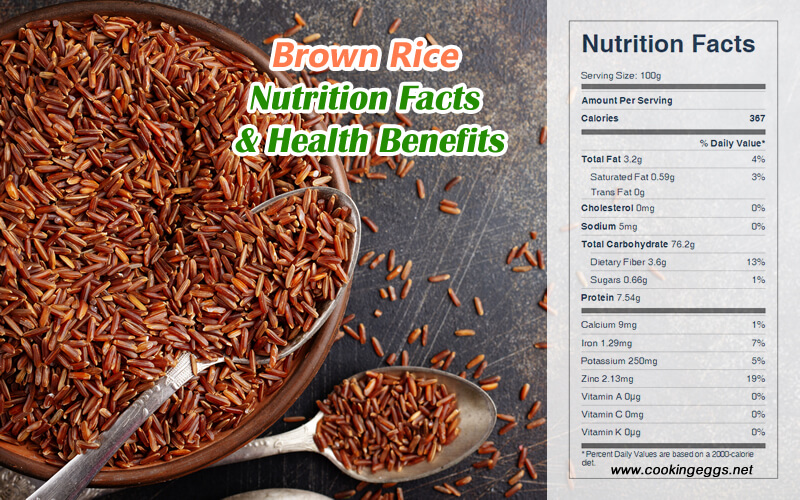Brown rice Nutrition Facts and Health Benefits
Brown rice is a whole grain rice with the inedible outer hull removed, with more fiber and more nutrients than its paler counterpart.
Nutritional value of Brown rice
Brown rice and white rice have similar amounts of calories and carbohydrates. Brown rice is a whole grain and a good source of magnesium, phosphorus, selenium, thiamine, niacin, vitamin B6, and manganese, and is high in fiber. White rice, unlike brown rice, has had the bran and germ removed and therefore has a different nutritional content.
One cup of cooked long grain brown rice provides 216 calories, 44.8 g carbohydrate, 5 g protein, 1.8 g fat, 3.5 g dietary fiber, 8 mcg folic acid, 84 mg potassium, 10 mg sodium, 162 mg phosphorus, 20 mg calcium, 84 mg magnesium, 1.23 mg zinc, and 1.77 mg manganese.

Brown rice Nutrition Facts Label
Health Benefits of Brown rice
Brown rice is a whole grain rice with the inedible outer hull removed. This kind of rice sheds its outer hull or husk but the bran and germ layer remain on, constituting the brown or tan colour of the rice. White rice is the same grain without the hull, the bran layer, and the cereal germ. Brown rice and white rice have similar amounts of calories and carbohydrates. Brown rice is a whole grain and a good source of magnesium, phosphorus, selenium, thiamine, niacin, vitamin B6, and manganese, and is high in fiber. White rice, unlike brown rice, has had the bran and germ removed and therefore has a different nutritional content.
Brown rice forms of it have a number of nutritional advantages over common rice, such as a higher content of protein, vitamins and minerals, oryzanols, tocopherols, and anthocyanins. In addition, it has other beneficial components, including polyphenolics, favonoids, vitamin E, and phytic acid.
Brown rice is a good source of selenium (33% of the DV), a trace mineral that is involved in many antioxidant reactions in the body and that plays a role in thyroid health. Selenium can either play a pro-oxidant role by inducing ROS or play an antioxidant role through selenoprotein synthesis. Selenium at nutritional levels is required for cell homeostasis, playing a role as an anti-oxidant through selenoproteins, thus acting chemo-preventive against cancer.
One cup of brown rice is high in manganese. One cup contains 88% of the recommended daily value for manganese. This mineral is involved in the metabolism of protein and carbohydrates, as well as the synthesis of a number of enzymes, proteins, fatty acids, and hormones.
Brown rice is high in fiber, which helps you feel full after eating and speeds the passage of food through the digestive tract. This may help maintain both a healthy body weight and a healthy colon. Cell invasion inhibitory compounds extracted from black rice exerted an inhibitory effect on various cancer cells. The fiber in brown rice helps to protect against colon cancer since fiber binds to cancer-causing chemicals, protecting them away from the cells lining the colon. In addition, it can help stabilize bowel function, reducing constipation. It was observed that a diet rich in fiber from whole grains, such as brown rice, and some fruit offered significant protection against brown rice cancer for premenopausal women.
Brown rice also helps to raise blood levels of nitric oxide, a small molecule known to induce blood vessel dilation and to inhibit oxidative (free radical) damage of cholesterol and the adhesion of white cells to the vascular wall, which are vital steps in the development of atherosclerotic plaques. Pigmented rice extracts have also been reported to effectively decrease oxidative stress, infammation, as well as atherosclerotic lesions.
Research suggests that regular consumption of whole grains lessens the risk of type 2 diabetes. In addition, a low-glycemic index diet with a higher amount of fiber and minimally processed whole grain products reduces glycemic and insulinemic responses and lowers the risk of type 2 diabetes.
Studies on brown rice have shown that it contains oil that lowers cholesterol. Consumption of rice bran oil lowered cholesterol by 7%. Researchers suggested that the unsaponifables existing in rice bran oil could become important functional foods for cardiovascular health. Studies reveal that eating whole grains, such as brown rice, is good for postmenopausal women with high cholesterol, high blood pressure, or any other signs of CVD. Experiments revealed that intake of at least six servings of whole grains by women each week experienced both slower progression of atherosclerosis, the buildup of plaque that constricts the blood vessels, and less progression of stenosis, the narrowing of the arterial passageways. The health benefits of brown rice are partly related to its fiber, which has been proven to reduce high cholesterol levels. One more way brown rice helps prevent atherosclerosis.
Brown rice, or dehusked rice with brown rice and germ, is rich in nutrients and health-beneficial nutraceuticals. In addition to the matrix of nutrients like fiber, vitamins, and minerals, the whole grain arsenal includes a wide variety of phytochemicals that reduce the risk of diseases. Compounds in whole grains that have disease-lowering effects include phenolic acids, proanthocyanidins, favonoids, anthocyanins, etc. Brown rice is also an important dietary source of water-soluble, fat-soluble, and insoluble antioxidants. Eating whole grains, such as brown rice, has been linked to protection against oxidative stress, atherosclerosis, diabetes, insulin resistance, hyperlipidemia, obesity, ischemic stroke, cancer, and premature death.
Considering the beneficial effects of brown rice, more research on the identification of bioactive components and bioactivities of brown rice as well as the development of value-added convenience health food products that can prevent present-day chronic diseases needs to be undertaken.